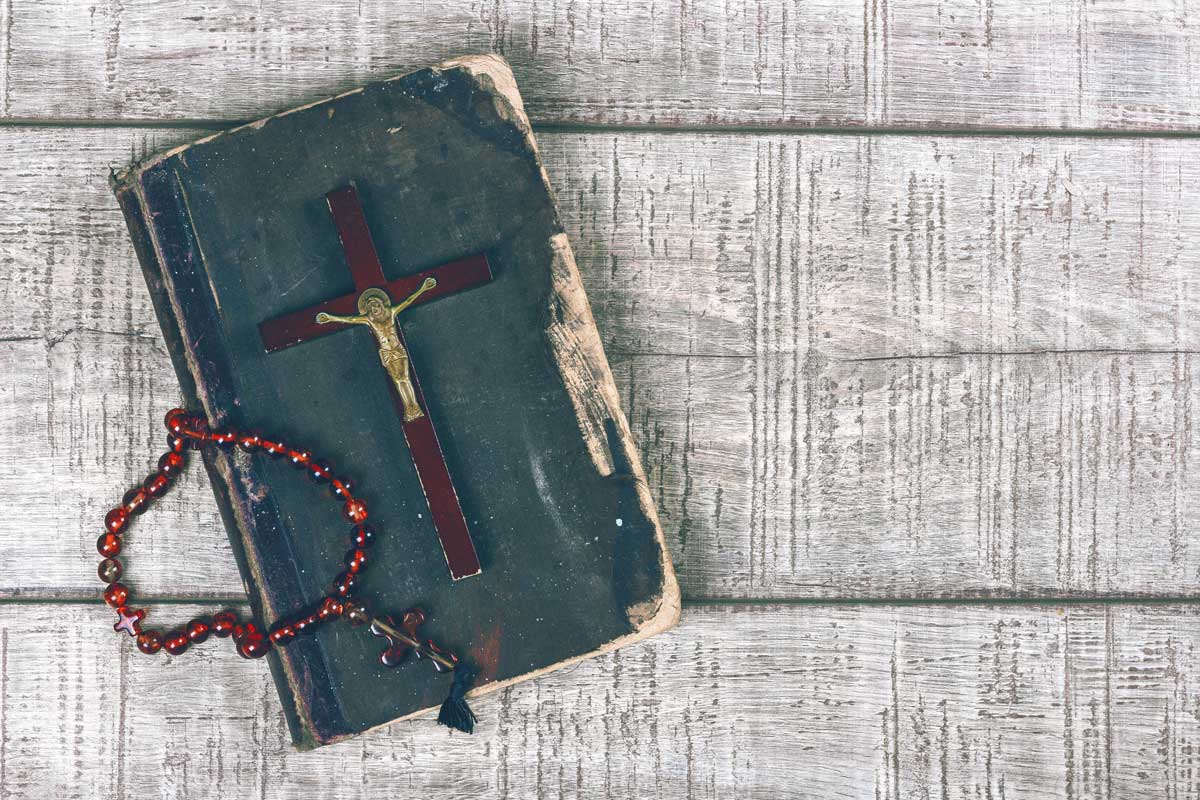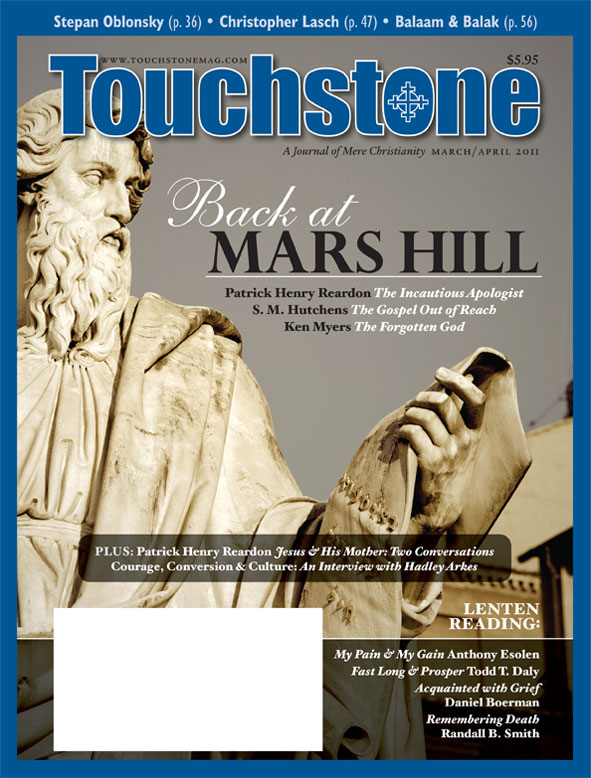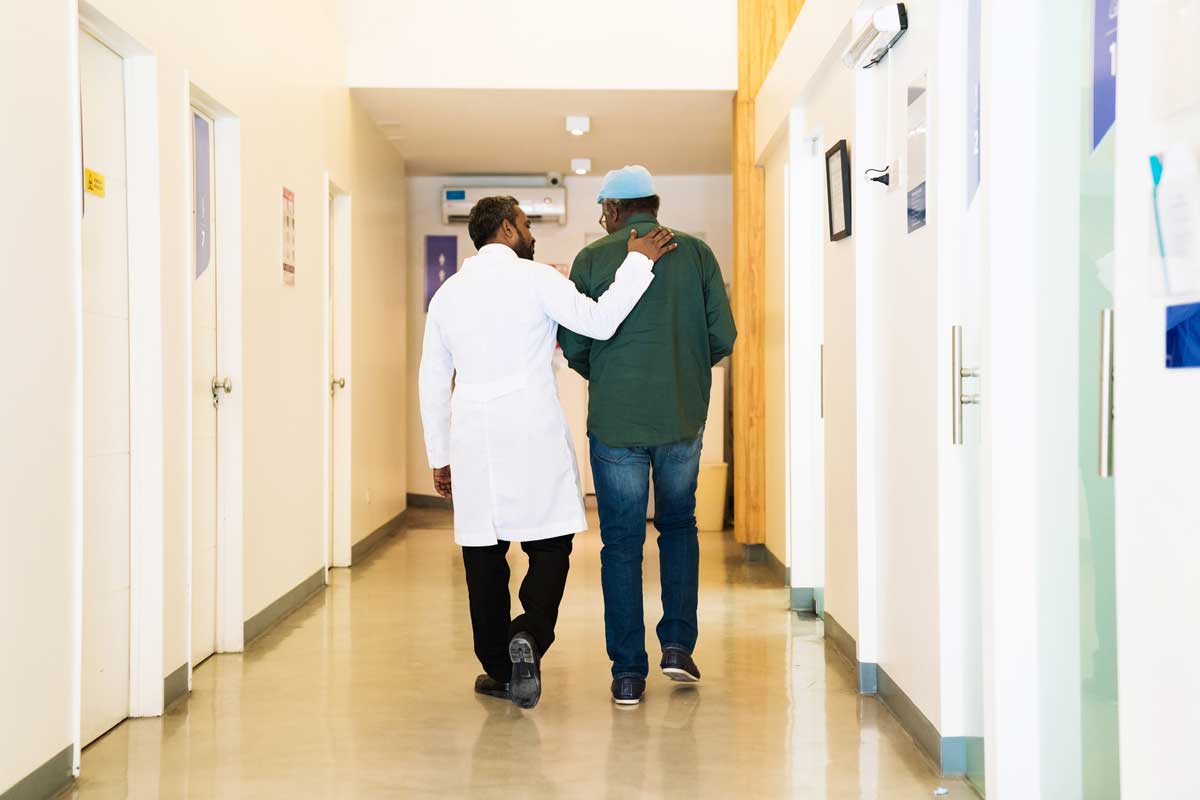My Pain & Gain
Anthony Esolen on the Blessings of a Bum Leg
My two friends, colleagues at the school where I teach, leaned over me as I lay on the floor, my left leg propped up on the radiator. They placed their hands on the leg, while the priest said the prayers and gave me the chrism of the sick—what used to be called Extreme Unction, but which can be requested by any Catholic in the straits of sickness, as I was. For I had not walked in over three months.
What happened to me that spring and summer is still a mystery to me, as is, I suppose, the leg I bear about with me, to which I am attached with something like the bones and ligaments of grudging affection. It is almost always in some pain or discomfort, always swollen. Apparently there are too few valves in the veins of the leg, so that blood and lymph tend to pool up in the foot and calf, which turn purple almost as soon as I stand up. I have had, therefore, to wear a compression garment of 45 pounds of pressure per square inch every day since I was a teenager, just to keep the leg from terrible pain, and to ward off the severe lymph infections I fall prey to once every year or so.
Pain & Protection
But the leg has been more to me than a source of pain and disease. It has, I must admit, been a protection, too. Other young people may have fooled themselves into believing they would never die; not me. I bore about with me a constant reminder of mortality and weakness. For when you are minding your business, feeling fine, chatting with friends, and then suddenly feel a chill, and a soreness in the lymph nodes of the groin, and know, with deep disappointment, that in an hour your fever will top 103 degrees, you become acutely aware of the transience of life, the poignant passing away of all that is beautiful in this marvelous creation.
More than that, the leg was an utterly unmerited protection against sin. I hope I am not boasting here, but I was a tanned and broad-shouldered Italian kid, with glossy black hair and a square jaw. I could have—but usually didn’t. The leg was, and is, so preposterous, so much of an explanation needing to be made, that I shied away from girls, and especially from beaches and swimming pools—despite the fact that the only time the leg feels normal when I am standing is when it is immersed in the blessedly heavy pressure of four or five feet of water.
Once, in college, I went four years without a date. Too shy for it, too keenly aware of something wrong, yet also, strangely enough, aware of the twistedness and the shame of sin, even when the bodies enveloping one another are such as to grace the covers of magazines.
Debilitation & Diagnosis
So there I was, finally married, by the grace of God, and lying on the floor. Something strange had happened to me months before. As near as I can figure, it began at the wake of a student of mine, who had either fallen or leapt to his death from a tall beech tree on campus; the notes he left us in the days before were full of his hopes for the summer and yet were phrased with unsettling ambiguity. Hundreds of students came to the wake, and so I and a few members of our campus men’s group stood outside in the parking lot, in bitter cold, for three hours, waiting to be admitted into the funeral parlor. From that terrible day on, the leg began to hurt for no apparent reason.
This was not psychological pain. It turned bright red whenever it was dependent, and swelled up, and over the course of several weeks became excruciating. The only relief I got was when it was elevated, so I learned to crawl about the house, crablike, leg in the air, even to make my way upstairs in our old Victorian house. Using the bathroom was, shall we say, a gymnastic adventure. My arms grew strong from the unusual exercise, while the legs grew thin and weak, and the painful one worsened.
After an utterly pointless and painful operation to repair a fistula—that is, an unnatural connection between a vein and an artery in my left foot—the doctors in Rhode Island gave up on me. Their only recommendations were to manage the pain, which seemed impossible, or to amputate. So I made an appointment with a supplier of prosthetics and met a very nice and cheerful double-amputee, who got around with great aplomb and told me that I would learn how to do that, too. My greatest worry, after all, had been that I would lose my job as a professor and not be able to support my family.
We sought a second opinion out of state. I was told that I had something called Reflex Sympathetic Dystrophy, which meant that one of my autonomic nerves was incorrectly signaling the capillaries in my leg to swell up with blood, exactly as if they were fighting off a massive infection. They would schedule a sympathectomy, major surgery involving the removal of the offending nerve, from the spine to the foot. That, I was told, stood a decent chance of success, though the corrupt signal could find another route eventually to do the same thing.
In the meantime, they tried one or two brief neural blocks, numbing me from the waist down, to see what might happen. Those blocks would buy me twelve hours of normality—one time I even went outside and mowed the lawn—but they were followed by the same old swelling and the same pain.
Prayer & Its Aftermath
And that is where matters stood when the priest with the healing ministry, and my devout friends, came to my home to lay hands upon me and pray. It is strange, but I remember those months of incapacity with some considerable fondness now. I prayed a lot, but mainly in a self-forgetful way; I prayed the rosary, assigning each separate prayer for the benefit of the students who had come to clean up my lawn, of the friends who drove me to the hospital, of the ladies who helped my wife by preparing meals, of people who called to chat on the phone, and of the members of my family, especially my sister the doctor, always a source of excellent advice. I say it with shame, but I doubt if my prayer has been as generous since, and in that sense my debility was a great gift.
So my friends left, and I was still stranded on the floor, when it occurred to me that the pain had not proceeded above my knee, as I had been afraid it would. In other words, if I could contrive a way to keep the lower leg elevated, I might be able to hobble about—and even meet my classes in September, before the scheduled operation. So I conceived the idea of tightly binding my leg backwards with a scarf, so that, if you looked at me front-on, you would think I had been amputated from the knee down. Meanwhile, I took out a pair of crutches lent to me by a friend, to see if I could make my way around the block—to be upright, and to see with what pain I would pay for it afterwards.
It was exhausting; I had grown weak in the lungs from the months of inaction. I had to stop once or twice to lie down. But when I finally returned home and unbound the scarf, I found to my surprise that the leg felt no worse. In fact, it felt marginally—maybe two percent—cooler and better. So I tried the experiment again the next day, and the day after that, till finally my palms were a mass of open blisters from leaning on the crutches. But every day the pain was a little less. Two weeks later, taking the crutches along, I drove my family to a little vacation on Cape Cod. When we returned, I put the crutches away for good.
When I wrote to the surgeon to tell him what had happened, he wrote back a simple sentence or two. “We’ll cancel the operation,” he said. “I don’t believe in poking a skunk.”
A Sign of Grace
Was I miraculously healed? I since have gotten on a Reflex Sympathetic Dystrophy mailing list, and from what I can gather, people suffer with this malady for years and years, sometimes all their lives. I have also learned that, paradoxically, lack of use makes the syndrome worse; but it is not clear to me how that applies to my healing, since I did not use the calf and foot again until the pain had begun to disappear. It seems that if something as simple as my scarf expedient were known to help, somebody somewhere would be suggesting it, but I haven’t seen it.
Now, you might think that after an event like this, my life would have been changed forever. But that would be to underestimate the human penchant for forgetfulness and ingratitude. Yet I look back upon those months now with a kind of wistful nostalgia. It was then—and not now, when I am racing about, writing articles here and delivering speeches there—that I was most at peace, because I was most grateful for the good things that people were doing for me. And that brings me to a theological point of some difficulty.
We are told that in the resurrection of the body, all deformities will have vanished; the glorified human form will be perfect. But, may God forgive me, I am still attached to this leg of mine, and though I want it healed, I want it also to be itself, and not something indistinguishable from the other leg. If it is perfectly itself, maybe then it will be an everlasting sign of weakness and humility, sort of like a martyr’s bloody badge of honor, only not so grand and impressive as that.
For I find it hard to think of it as an evil, when it has spared me so much evil and been the source of so much good. Why I write this now, after eight years have passed, I am not sure, except that many of my readers may know of something comparable in their own lives, some surprising instance of the grace of God coming to us in the most unexpected ways. I pray only now that I may run—if with a noticeable hitch—the race to the finish.
Anthony Esolen is Distinguished Professor of Humanities at Thales College and the author of over 30 books, including Real Music: A Guide to the Timeless Hymns of the Church (Tan, with a CD), Out of the Ashes: Rebuilding American Culture (Regnery), and The Hundredfold: Songs for the Lord (Ignatius). He has also translated Dante’s Divine Comedy (Random House) and, with his wife Debra, publishes the web magazine Word and Song (anthonyesolen.substack.com). He is a senior editor of Touchstone.
subscription options
Order
Print/Online Subscription

Get six issues (one year) of Touchstone PLUS full online access including pdf downloads for only $39.95. That's only $3.34 per month!
Order
Online Only
Subscription

Get a one-year full-access subscription to the Touchstone online archives for only $19.95. That's only $1.66 per month!
bulk subscriptions
Order Touchstone subscriptions in bulk and save $10 per sub! Each subscription includes 6 issues of Touchstone plus full online access to touchstonemag.com—including archives, videos, and pdf downloads of recent issues for only $29.95 each! Great for churches or study groups.
Transactions will be processed on a secure server.
more from the online archives

24.6—Nov/Dec 2011
Liberty, Conscience & Autonomy
How the Culture War of the Roaring Twenties Set the Stage for Today’s Catholic & Evangelical Alliance by Barry Hankins
calling all readers
Please Donate
"There are magazines worth reading but few worth saving . . . Touchstone is just such a magazine."
—Alice von Hildebrand
"Here we do not concede one square millimeter of territory to falsehood, folly, contemporary sentimentality, or fashion. We speak the truth, and let God be our judge. . . . Touchstone is the one committedly Christian conservative journal."
—Anthony Esolen, Touchstone senior editor








